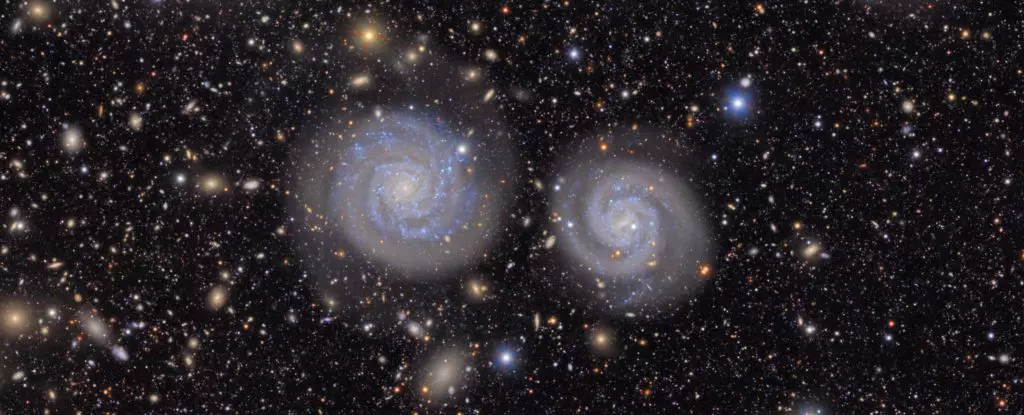In an age where humanity’s quest for cosmic understanding grows ever more relentless, the Vera C. Rubin Observatory has emerged as a beacon of innovation and insight. The release of its inaugural images marks a transformative moment, promising vast improvements in our comprehension of the universe’s enigmatic fabric. Situated under the auspices of the U.S. National Science Foundation and the Department of Energy, this state-of-the-art facility used its advanced imaging capabilities to gaze deep into the cosmos for ten uninterrupted hours. The results reveal more than just enchanting visuals—they present a profound new tool for the exploration of celestial phenomena.
Brian Stone, the acting director of the NSF, aptly states that “the NSF-DOE Rubin Observatory will capture more information about our Universe than all optical telescopes throughout history combined.” Such a claim is not merely grandiose; it is a reflection of the groundbreaking technology housed within this facility. By employing a camera that captures light across near-ultraviolet, optical, and near-infrared wavelengths, the Rubin Observatory stands ready to unveil cosmic mysteries, including the elusive dark matter and dark energy that shape our understanding of space.
Unearthing the Legacy Survey of Space and Time
At the heart of the Vera C. Rubin Observatory’s mission is a decade-long initiative titled the Legacy Survey of Space and Time (LSST). Its ambitious goal is to meticulously document the southern sky. By utilizing its innovative 3,200-megapixel camera—the most extensive optical camera in existence—the observatory will create an unprecedented 10-year timelapse of astronomical phenomena. This enormous database will enable the observatory to revisit various segments of the sky approximately 800 times throughout its operational life.
The LSST will capture a plethora of dynamic events: it will track asteroids, comets, supernovae, and pulsars, constructing a comprehensive inventory of moving objects within our Solar System and beyond. The promise of this monumental undertaking is tantalizing, as researchers will finally have the capacity to chronicle transient cosmic events with unprecedented clarity.
A Glimpse into the Cosmos
Rubin’s inaugural images are a testament to the facility’s immense potential. Among its first accomplishments was the production of an extraordinarily detailed mosaic of the Milky Way’s Trifid and Lagoon nebulae. Over a span of 7.2 hours, the telescope captured 678 individual images, seamlessly merging them into a stunning composite that is just shy of 5 gigapixels in size. This mosaic invites both professional astronomers and amateur enthusiasts to immerse themselves in a deeply interactive experience; it’s not just data, but a portal into the cosmos.
Moreover, the observatory’s capability to focus on specific sections of the sky has yielded a breathtaking view of around 10 million galaxies concentrated around the Virgo cluster. Such visualizations provide a glimpse into the vastness of the universe and challenge us to appreciate the sheer scale of celestial diversity. The observatory also reported its ability to identify more than 2,100 previously unrecorded asteroids in just over ten hours, exceeding annual discoveries made by all other ground-based telescopes.
An Instrument of Cosmic Defense
One of the inherent missions of the Rubin Observatory lies in planetary defense against potentially hazardous asteroids. While the initial findings indicate that none of the newly discovered asteroids threaten Earth, their identification underscores the observatory’s critical role. The ability to catalog emerging celestial bodies not only enhances our understanding of the solar environment but also prepares humanity better for unexpected apocalyptic scenarios.
The NSF and DOE emphasize that the Rubin Observatory is a unique instrument in the realm of astronomical research, not for its optical prowess alone, but for its distinct design, unparalleled camera sensitivity, rapid observational capabilities, and robust computational systems. The advances heralded by this observatory open pathways to unravel cosmic phenomena that have long eluded our grasp, allowing us to question and explore realms of the universe previously limited to speculation.
As the Vera C. Rubin Observatory embarks on its profound journey, the astronomical community and curious minds alike anticipate a cascade of discoveries. The next decade promises to deepen our understanding of the universe’s complexities, inviting humanity to witness the hidden wonders that lie beyond the stars.


Leave a Reply